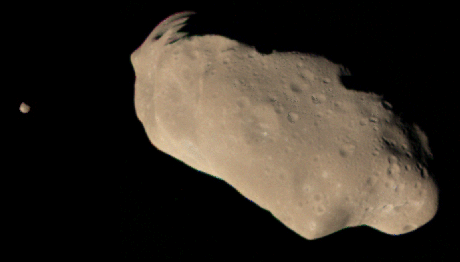

NASA's Origins program seeks to understand how life arose on Earth, and to determine if life exists anywhere else in the Universe. The Sun powers almost all life on Earth and, in fact, is responsible for the planet's very existence. Yet the Sun is an ordinary star, one of approximately 100 billion in the immense conglomeration of stars that is our galaxy. In order to understand the origin of life, it is necessary to understand the origin of stars. The goal of NASA's Wide Field Infrared Explorer (WIRE) spacecraft is to understand the history of star formation in the Universe.
![]()
The Milky Way in Visual Wavelengths
Current observations suggest that stars and their planetary systems form when massive interstellar clouds of gas and dust collapse. Thus, most star forming regions are shrouded by clouds that block the visible and ultraviolet light emitted by young stars. This makes the star formation process inaccessible to ordinary visible light telescopes. However, infrared light can pass through these clouds. The WIRE telescope makes its observations using infrared light. Light of this type is not visible to the human eye, and is perceived as heat.
![]()
The Milky Way in Infrared Wavelengths
Although the star formation process is brief by
astronomical time scales, it is extremely long compared to human experience, lasting
perhaps hundreds of thousands to millions of years. No human observation could ever
view a single star through all its birth phases. Thus, WIRE will make observations
of many stars in different phases, with the intention of providing enough data to assemble
a history typical of all stars. This is similar to how botanists study tree
growth. It would be impractical to observe a single tree throughout its entire
lifetime, so botanists survey an entire forest, hoping to find different examples of a
certain species at different stages in its life cycle. WIRE will survey a
"forest" of star forming regions by observing entire galaxies rather than
individual stars. It will take the star formation inventory of 100,000 galaxies
within a region of the sky equal to 5,000 times the area of the full moon, or between two
and three percent of the celestial sphere. This large area may allow WIRE to detect
rare objects or new phenomena within its brief, four month planned mission.
WIRE will concentrate its observations on starburst galaxies, extremely bright galaxies
that are producing new stars at ten times the rate of typical galaxies. It will also
search for ultraluminous galaxies, very bright, possibly extremely distant galaxies with
intense star formation. WIRE will examine the remote Universe to determine the large
scale distribution of galaxies, which will be used to test competing theories of galaxy
formation.

Observing distant objects is important when studying
the history of the Universe because distance equals time. This is because light
travels at a finite speed. For example, if an object is 100 light years away from
us, the light we are seeing from it now was actually emitted 100 years ago, because it
took 100 years for its light to travel to Earth. This means we are actually seeing
the object as it appeared a century ago. Its image acts as an astronomical
"fossil", preserving a record of the object's past. Some of the
ultraluminous galaxies may be billions of light years away, possibly representing the
first galaxies to form.
WIRE will also make observations closer to home. It will look into the star forming
regions in our own galaxy. It will also help to discover the structure of our
galaxy. The galaxy is shaped like a disk, and we are located near the edge.
This makes it difficult to determine the galaxy's structure, because dust clouds in the
inner portions of the disk block our view. Since WIRE can see through those clouds,
it will help determine galactic structure.
WIRE will search for a kind of "failed" star, called a brown dwarf. Brown
dwarfs are relatively small objects that shine faintly, mostly in infrared light.
They do not shine for the same reasons that a normal star shines. A normal star
shines because of energy supplied by nuclear fusion reactions in its central core.
Brown dwarfs, at about 80 times as massive as Jupiter, still have too little mass to
sustain nuclear fusion reactions in their cores. Instead, they glow dimly with the
heat left over from their contraction. WIRE should be able to detect their feeble
light up to about 35 light years away.

A young star and its circumstellar disk (HST).
When a star forms from a collapsing cloud, it often is surrounded by a disk of material from that cloud. It is believed that planets form out of the material in these disks. The circumstellar disks absorb light from the star and radiate it again as infrared light. WIRE will thus be able to scan stars for circumstellar disks, possibly finding clues to planet formation.

WIRE will look within our own solar system as well. It will take an inventory of main belt asteroids to determine if there is an increase in the number of smaller ones (less than 1.25 miles across) as predicted. It will also observe comet trails, dust that has been ablated from comets as their orbit takes them close to the Sun and exposes them to strong solar radiation. As the Earth progresses in its orbit, it occasionally intersects a comet trail. The result is often a spectacular meteor shower, as the high speed dust grains burn up harmlessly in our atmosphere. However, as our satellite constellation grows, these showers become an increasing concern. If the shower is particularly intense, the satellites will be "sandblasted" by the dust. Although less common, impacts with the larger grains poses a greater threat because the impact vaporizes the grain and the tiny impact area on the satellite, forming a cloud of electrically charged gas called plasma that can short-circuit sensitive electronic components.
![]()
Last Updated: 12/2/98